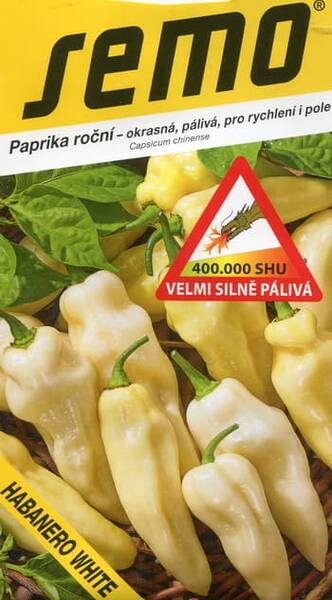A spicy seasoning all year round!
A super-hot Peruvian pepper variety. Plants grow up to 60 cm tall with vigorous lateral branching.
The pods are light green at technical maturity, but become milky white at the biological stage of ripening.
The spiciness of this variety is very high (up to 400,000 units on the Scoville scale).
The aroma is fruity and floral, the taste is sweet. The growing season is 190 days.
In northern regions, it is grown in greenhouses and hotbeds. It can also be grown indoors in pots as small as 2 liters.
Intended for fresh consumption (for seasoned food lovers) and for making sauces.
* Scoville scale.
Wilbur Lincoln Scoville (1865-1942) was a renowned American pharmacist who earned a PhD from Columbia University in 1929 and created the Scoville Scale. He worked for the Parke Davis pharmaceutical company in Detroit. It was here in 1912 that he conducted tests to determine the pungency of various pepper varieties. Today, the company belongs to one of the world's largest corporations, Phizer, but at that time it was a very large and oldest pharmaceutical manufacturer in the United States.
In 1920, Wilbur Scoville developed the Scoville Organoleptic Test, which rated the heat of a pepper sample in specific units—Scoville Heat Units (SHU). This test was initially designed to measure capsaicin levels—the element directly responsible for the hot taste of red pepper (in black pepper, a different component, piperine, is responsible for the heat).
In general, pure capsaicin (8-methyl-n-vanillyl-6-nonenamide) is a colorless crystalline powder that is soluble in alcohol and insoluble in cold water. It can be used in medicine (various warming ointments, tinctures, and patches), as well as in the production of self-defense weapons (gas canisters, pistols). One kilogram of pure capsaicin costs approximately 5,000 euros.
In its pure form, it can be very dangerous for humans, as even 1.0 mg placed on a person's hand causes pain like a hot iron, after which the skin immediately becomes covered in blisters...
Animal studies have shown that the lethal dose of capsaicin consumed in food is 100 mg/kg (for mice). However, for a 60 kg human, death would only occur if they rapidly ingested nearly 2 kg of hot peppers... (which is practically impossible).
To determine capsaicin content organoleptically, Scoville first dissolved a precisely measured amount of a specific pepper sample in alcohol, then divided the prepared solution into five portions and called five testers. For each tester, he gradually added a certain amount of sweetened water to the given portion of alcohol solution, and the resulting mixture was then sampled. (Water was added until three of the five testers no longer detected the hot taste, at which point the test was considered complete.) The results were then calculated: if 1,000 parts of water were required to remove the hot taste from one part of the alcohol solution, then that pepper variety was assigned a potency of 1,000 SHU.
Subsequently, the Scoville Scale was standardized taking into account the presence of pure capsaicin, determined by more accurate methods (currently chromatographic): 6.6% pure capsaicin corresponds to 1 million SHU, and 100% - 16 million SHU.
Scoville and his followers empirically obtained the heat values for the main varieties of pepper, and as a result, the modern "Scoville table" for "hotness" ratings looks like this:
15,000,000 - 16,000,000 Pure capsaicin
9 100 000 - 15 000 000 Capsaicinoids: dihydrocapsaicin, nordihydrocapsaicin, etc.
2,000,000 - 5,300,000 Pepper sprays (USA)
1,200,000 - 1,460,000 Trinidad Scorpion Butch T
855,000 - 1,041,427 Bhut Jolokia, Naga Jolokia ("Naga Jolokia")
876 000 - 970 000 Dorset Naga, Tezpur
350,000 - 577,000 Red Savina Habanero
100,000 - 350,000 Habanero (Habanero Chile), Madame Janette
100,000 - 350,000 South American chinenses, African birdseye
100,000 - 200,000 Jamaican Hot Pepper
50,000 - 100,000 Birds Eye, Thai Pepper, Thai Pepper, Malagueta Pepper, Chiltepin Pepper, Tepin, Chinese kwangsi
30,000 - 50,000 Capsicum Frutescens, Aji pepper, Tabasco pepper, Piquin, Pakistan dundicut
10,000 - 25,000 Serrano pepper, de Arbol, Crushed Red Pepper, Red pepper of the highest grade Coral
7,000 - 8,000 Tabasco Sauce (Habanero)
5,000 - 10,000 Wax Pepper, Early Jalapeño
2,500 - 8,000 Jalapeno Peppers
2,500 - 5,000 Tabasco Sauce (Tabasco pepper), Louisiana hot sauce, Pasilla, Mirasol, Chipotle
1 500 - 2 500 Rocotillo Pepper, Sandia, Cascabel, Yellow Wax Hot
1 000 - 1 500 Draky, Anaheim, Poblano Pepper, Mild Jalepeno
600 - 800 Tabasco Sauce (Green Pepper)
500 - 1000 Ancho, Cherry, New Mexico
100 - 500 Allspice Pimiento (Pimenta), Pepperoncini, Pickled pepperoncini, Hungarian pepper
0 - Sweet paprika (bell pepper).
* Capsaicin is an alkaloid found in various species of Capsicum (for example, in the fruits of the common pepper, it contains about 0.03%). Pure capsaicin, or 8-methyl-n-vanillyl-6-nonenamide, is a whitish powder that is soluble in alcohol and insoluble in cold water (this is why drinking water won't help relieve the burning sensation from peppers; an alcohol-containing liquid, such as vodka, tequila, or beer, is required).
* Capsaicin is quite unique compared to other spicy substances: this powerful irritant, unlike, for example, mustard oil (zingerone and allyl isothiocyanate), black pepper (piperine) and ginger (gingerol), causes addiction after taking regular doses of low concentration, which allows you to subsequently consume "hot-spicy" dishes: this effect is caused by the selective degeneration of certain primary sensory neurons and a person simply stops feeling the spiciness...












